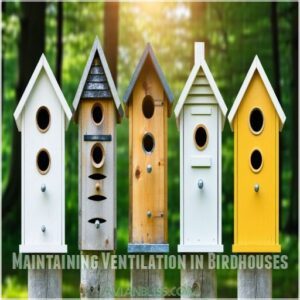This site is supported by our readers. We may earn a commission, at no cost to you, if you purchase through links.
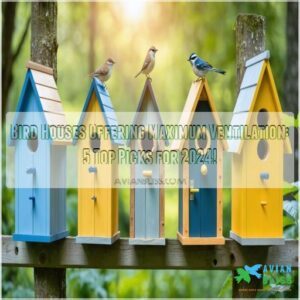 When you’re crafting bird houses offering maximum ventilation, you’ll want to think like a bird architect!
When you’re crafting bird houses offering maximum ventilation, you’ll want to think like a bird architect!
Strategic air holes (about 1/4 to 1/2 inch) near the top of your birdhouse are your secret weapon. These tiny breathers prevent moisture buildup, regulate temperature, and keep your feathered tenants cool and comfortable.
Don’t go overboard—two to four small, smooth-edged holes per side strike the perfect balance between airflow and predator protection.
Cedar and recycled plastic make excellent, breathable materials.
Pro tip: Look for designs with built-in drainage and air gaps, like the Woodlink Bluebird House, which practically guarantees your avian friends won’t break a sweat.
Table Of Contents
- Key Takeaways
- Importance of Ventilation in Birdhouses
- Top 5 Birdhouses Offering Maximum Ventilation
- Designing Birdhouses for Optimal Ventilation
- Maintaining Ventilation in Birdhouses
- Frequently Asked Questions (FAQs)
- How much ventilation does a birdhouse need?
- Where not to put a bird house?
- Do bluebird houses need ventilation?
- Can you put two bird houses close together?
- Do different bird species need different ventilation?
- Can poor ventilation cause bird health problems?
- How often should birdhouse ventilation holes be checked?
- What materials provide best natural birdhouse ventilation?
- Are commercial or DIY ventilation designs better?
- Conclusion
Key Takeaways
- You’ll want to strategically place 1/4- to 1/2-inch ventilation holes near the top of your birdhouse, ensuring optimal air circulation without compromising predator protection.
- Choose breathable materials like cedar or recycled plastic that naturally regulate temperature and prevent moisture buildup, keeping your feathered friends comfortable and healthy.
- Aim for two to four small, smooth-edged holes per side to strike the perfect balance between airflow and safety, protecting nestlings from overheating and respiratory issues.
- You can upgrade existing birdhouses by adding drainage holes, using rot-resistant materials, and installing removable clean-out panels to maintain a high-quality, well-ventilated bird sanctuary.
Importance of Ventilation in Birdhouses
You’ve heard that birdhouses are more than just cute backyard decorations – they’re critical shelters.
proper air circulation is needed to keep your feathered friends healthy.
Ensuring your birdhouse has adequate ventilation means protecting nesting birds from humidity, temperature extremes, and potential respiratory issues.
These issues could harm their delicate young.
How Much Ventilation Does a Birdhouse Need
How much ventilation does a birdhouse really need?
The sweet spot is typically 1-2 small holes (around 1/4 inch in diameter) per side, strategically placed near the top for ideal birdhouse airflow.
These ventilation holes are vital for preventing moisture buildup, regulating temperature, and keeping your feathered friends cool during sweltering summer days.
Proper sizing matters – too small won’t cut it, too large invites predators.
To select the right birdhouse for your needs, consider checking out ventilated birdhouses online, which are specifically designed with ventilated birdhouse features.
Why Ventilation is Crucial for Bird Health
Because proper ventilation can be a lifeline for birds, understanding its critical role is key to keeping feathered friends healthy.
Adequate air circulation prevents mold growth, regulates temperature, and maintains ideal air quality inside birdhouses.
Without good ventilation, chicks can suffer from overheating, increased pest risks, and compromised respiratory health, turning their safe haven into a potential danger zone. This highlights the importance of proper ventilation for bird health.
Types of Ventilation in Birdhouses
In the context of birdhouse ventilation, you’ve got more options than a bird has feathers. From side vents to roof openings, ventilation designs range from passive to active cooling strategies.
Essential ventilation hole sizes typically measure 1/4 to 1/2 inch, strategically placed to prevent overheating while maintaining ideal airflow for your feathered friends’ comfort and health.
Considering the diverse bird species in your area, such as the American Goldfinch, is essential when selecting a birdhouse with proper ventilation.
Top 5 Birdhouses Offering Maximum Ventilation
If you’re on a mission to create the perfect bird sanctuary, you’ll want to know which birdhouses offer the best ventilation for your feathered friends.
These five top-rated birdhouses will help you keep your backyard birds cool, comfortable, and chirping with joy throughout the year.
1. Woodlink Bluebird House Birdhouse Wooden Home
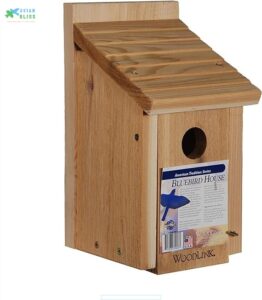
Crafted from reforested inland red cedar, the Woodlink Bluebird House stands out as a ventilation champion for bird enthusiasts.
Its ingenious 1/2-inch air gap at the top guarantees birds stay cool and comfortable, while the thoughtfully designed drain hole at the base prevents moisture buildup.
You’ll appreciate the easy-open front panel that makes cleaning a breeze, and the rust-resistant zinc chromate screws promise durability.
With a carefully centered 1 1/2-inch entrance hole, this birdhouse welcomes bluebirds like a five-star avian resort.
Best For: Bird enthusiasts looking for a durable, easy-to-clean bluebird house that’s simple to assemble and maintain.
- Durable construction using reforested cedar and rust-resistant screws.
- Easy-access front panel for convenient cleaning.
- Designed to attract bluebirds while discouraging larger birds.
- Some assembly issues reported, including misaligned screw holes.
- Potential for unwanted bird species to occupy the house.
- May require modifications to deter larger birds.
2. Cedar Wren House Birdhouse Nature Way

At the heart of backyard bird lovers’ dreams sits the Nature’s Way Cedar Wren House – a ventilation champion designed to keep our feathered friends cool and comfortable.
Its premium cedar construction features strategic air vents and drainage gaps that prevent moisture buildup.
The 1 1/8" entrance hole smartly keeps larger birds out and welcomes wrens and chickadees.
To facilitate birdhouse maintenance, consider a design with a removable floor for easy cleaning.
With rust-free stainless-steel hardware and a sturdy hanger, this birdhouse isn’t a shelter – it’s a lightweight fortress of avian comfort.
Best For: Bird enthusiasts seeking a durable, well-ventilated birdhouse to attract wrens and chickadees.
- Durable cedar wood construction with rust-free hardware.
- Strategically placed air vents and drainage gaps for ventilation.
- 1 1/8" entrance hole, perfect for wrens and chickadees, deterring larger birds.
- Minor imperfections like rough edges or scuffed stain may be present.
- Latch may require modification for improved function.
- A portal protector is recommended to prevent chewing on the entrance hole.
3. Perky Pet Wren Birdhouse Home
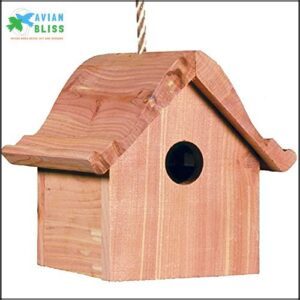
Looking for a cozy home for your feathered friends? The Perky Pet Wren Birdhouse brings aromatic cedar charm to your backyard sanctuary.
Measuring a compact 6.5 inches tall, it’s perfectly sized for wrens and finches, with a 1.5-inch entry hole that welcomes small birds while keeping larger predators out.
Hanging conveniently with its integrated rope, this birdhouse offers a simple yet elegant solution for bird lovers.
Its Dutch-style roof adds a touch of classic design that’ll make both birds and garden enthusiasts smile.
Best For: Those seeking an attractive, easy-to-clean birdhouse suitable for wrens, finches, and other small birds.
- Attractive design and easy to clean.
- Durable construction (though some reports of rickety construction exist).
- Competitively priced.
- Some report the entry hole is larger than expected.
- Some find the construction less sturdy than expected.
- May not look exactly as pictured.
4. Starling Resistant Birdhouse Medium White Grey
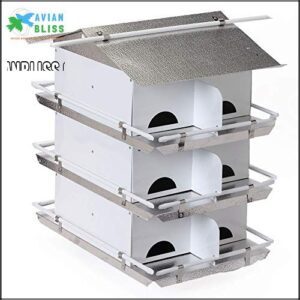
In the realm of Purple Martin homes, the Starling Resistant Birdhouse stands out as a fortress of safety.
With its impressive three-story design and twelve rooms, this aluminum marvel keeps unwanted guests at bay while welcoming Purple Martins.
Boasting a 99.8% starling prevention rate, it’s like a bouncer for bird habitats.
The hinged doors and reflective roof make maintenance a breeze, and its sturdy construction makes certain your feathered friends have a high-quality, predator-proof sanctuary that’ll make other birdhouses green with envy.
Best For: Those seeking a high-quality, durable, and starling-resistant Purple Martin house with enhanced security features.
- 99.8% effective in preventing starling entry.
- Sturdy aluminum construction for long-lasting use.
- Easy cleanout thanks to hinged doors.
- Assembly instructions could be improved for clarity.
- Assembly may require additional tools and time.
- International shipping may incur additional costs.
5. Tenforie Hanging Bird House Grass Nest
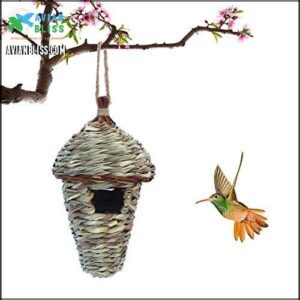
Anyone passionate about bird-friendly spaces might find the Tenforie Hanging Bird House a unique solution.
Crafted from 100% natural woven grass fiber, this biodegradable birdhouse offers small birds like hummingbirds and goldfinches a breathable, eco-friendly shelter.
Its lightweight design (just 3.31 ounces) and versatile hanging capabilities make it perfect for various outdoor settings.
While customer reviews are mixed, the house’s natural appearance and potential for providing a safe hideaway make it an intriguing option for bird enthusiasts seeking a more organic nesting environment.
Best For: Bird enthusiasts seeking a natural, eco-friendly nesting option for small birds.
- Biodegradable and environmentally friendly.
- Natural appearance blends seamlessly into outdoor spaces.
- Versatile hanging and placement options.
- Mixed customer reviews regarding product quality and bird usage.
- Some reports of defective manufacturing and shipping damage.
- Not guaranteed to attract birds.
Designing Birdhouses for Optimal Ventilation
When you’re creating a birdhouse, proper ventilation isn’t just a nice-to-have—it’s essential for your feathered friends’ survival and comfort.
You’ll want to focus on strategic hole placement, breathable materials, and smart design features that keep your backyard birds cool, healthy, and happy in their cozy new home.
Choosing The Right Materials for Ventilation
After exploring top ventilated birdhouses, you’ll want to nail down the perfect materials for maximum bird comfort.
Your material choice can make or break a happy avian home.
Consider these key factors:
- Cedar’s natural moisture resistance and durability
- Recycled plastic’s eco-friendly and weather-resistant properties
- Pine’s excellent insulation and cost-effectiveness
When selecting materials, think breathability meets bird sanctuary.
Design Considerations for Ventilation Holes
When selecting hole sizes for birdhouse ventilation, smart design makes all the difference. Your feathered friends need just the right balance of airflow and protection.
Check out this quick guide to ventilation hole design:
| Design Aspect | Recommended Approach |
|---|---|
| Hole Size | 1/4" to 3/8" diameter |
| Hole Shape | Round or small squares |
| Material Impact | Smooth edges prevent injury |
| Number of Holes | 2-4 per side for balanced circulation |
Precision matters when crafting those critical air passages!
Placement of Ventilation Holes for Maximum Effect
If you’re aiming for maximum birdhouse ventilation, strategic hole placement is key.
Position ventilation holes near the top of the birdhouse to create ideal airflow direction, ensuring cool air enters while hot air escapes.
Multiple small holes work better than one large opening, preventing predator access while maintaining excellent air circulation for your feathered friends.
Maintaining Ventilation in Birdhouses
You’ll want to keep your birdhouses fresh and functional by regularly checking and maintaining their ventilation system.
By understanding how to clean, inspect, and upgrade your birdhouse’s air circulation, you’ll create a healthier habitat that birds will love calling home.
Cleaning and Maintenance Tips for Ventilation
During spring cleaning, your birdhouse ventilation needs some serious TLC.
Keep those feathered friends healthy with a proactive maintenance approach:
- Scrub ventilation with soft-bristled brushes
- Check for accumulated debris that might obstruct air circulation
- Inspect seals and edges for potential mold growth spots
Regular cleaning prevents humidity buildup and maintains birdhouse air quality at its best, protecting your avian friends’ respiratory health.
Avoiding Common Mistakes That Block Ventilation
Many birdhouses fail due to blocked vents, which can turn nesting spaces into danger zones.
Improper cleaning, poor material choice, and incorrect placement create ventilation nightmares for feathered residents.
Avoid covering critical air holes with debris or inappropriate predator guards.
Verify that your birdhouse ventilation design allows fresh air circulation, preventing moisture buildup and protecting delicate bird habitats from potential health risks.
Upgrading Existing Birdhouses for Better Ventilation
Don’t let a poorly ventilated birdhouse cramp your feathered friends’ style! Consider adding ventilation upgrades for improved airflow, as proper ventilation is essential for a healthy nesting environment.
Upgrading existing birdhouses is easier than you might think.
Here’s how to breathe new life into your avian abodes:
- Drill strategic ventilation hole sizes above and below entrance
- Replace worn materials with breathable, rot-resistant cedar
- Add drainage holes to prevent moisture buildup
- Install removable clean-out panels for easy maintenance
Your winged buddies will thank you for the fresh makeover!
Frequently Asked Questions (FAQs)
How much ventilation does a birdhouse need?
Like a gentle breeze for feathered friends, your birdhouse needs strategic ventilation.
Installing best birdhouse vents is essential for maintaining a healthy bird environment.
Small holes near the roof help regulate temperature, prevent moisture buildup, and keep nestlings cool and comfortable during warm months.
Where not to put a bird house?
Steer clear of birdhouses near busy areas, predator-prone zones, direct sunlight, or extreme weather.
Avoid placing them too close to bird feeders, noisy spaces, or regions with high human traffic that’ll stress out your feathered friends.
This will help you choose a safe location for your birdhouses.
Do bluebird houses need ventilation?
Yes, bluebird houses absolutely need ventilation!
Proper air circulation prevents overheating, reduces moisture buildup, and helps keep nestlings healthy.
You’ll want small ventilation holes near the top of the box to guarantee your feathered friends stay comfortable.
Can you put two bird houses close together?
In the world of bird real estate, you’ll want to play it smart.
Two birdhouses can cozy up nearby, but only if they’re for different species.
Space them apart to prevent territorial disputes and make certain each feathered family feels right at home.
Do different bird species need different ventilation?
Bird species have unique ventilation needs based on their size, habitat, and nesting habits.
Different birds require specific hole sizes, placement, and airflow patterns to maintain ideal temperature and prevent moisture buildup in their homes.
Can poor ventilation cause bird health problems?
Stifling air can be a death trap for feathered friends.
Poor ventilation in birdhouses creates a breeding ground for harmful moisture, mold, and parasites.
This can potentially cause respiratory issues and compromise the health of nesting birds. Poor ventilation is a serious problem.
How often should birdhouse ventilation holes be checked?
You’ll want to inspect birdhouse ventilation twice yearly.
during spring cleaning before nesting season and after breeding season ends.
Quick checks prevent moisture buildup and guarantee your feathered friends’ comfort and health.
What materials provide best natural birdhouse ventilation?
Cedar and untreated pine naturally breathe best for birdhouses, offering superior air circulation.
Their porous wood allows moisture to escape.
This maintains ideal internal temperatures, keeping feathered friends comfortable and healthy.
Are commercial or DIY ventilation designs better?
Nestled in nature’s embrace, DIY birdhouses often outshine commercial designs.
You’ll craft better ventilation by drilling strategic 1/8-inch holes.
Ensuring airflow while protecting your feathered friends from temperature extremes and moisture buildup.
Conclusion
Soaring high like an eagle’s wingspan, your quest for bird houses offering maximum ventilation ends here!
You’ve learned that great birdhouses aren’t just shelters—they’re sanctuaries of comfort.
Whether you’re a backyard birder or wildlife enthusiast, these ventilation strategies will transform your birdhouses into five-star avian retreats.
Remember, good airflow means happy, healthy birds.
Don’t just build a house—create a home that’ll make your feathered friends tweet with joy!



